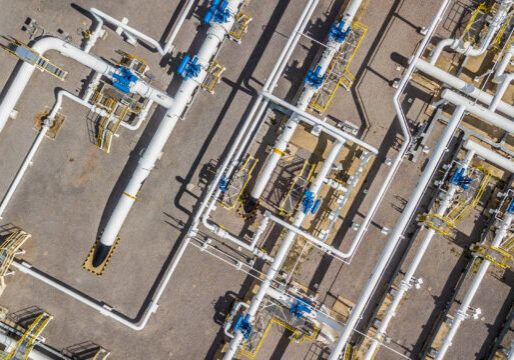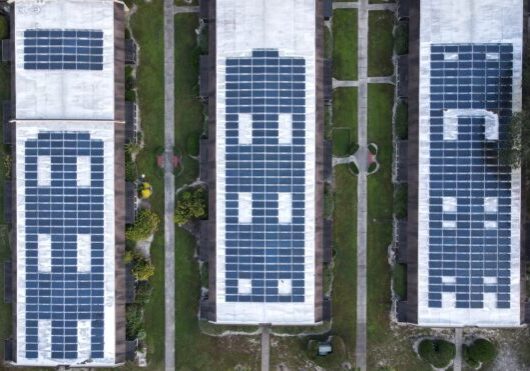June 4, 2025
Hydrogen production’s unbreakable ties to fossil fuels in the US
By Eva Morgan
For the past few years, hydrogen has been proposed as a method of reducing emissions in almost every sector, from energy production, to transportation, to manufacturing. This has led to a boom in proposed hydrogen production plants, mainly focused on so-called low carbon hydrogen. But hydrogen production isn’t new. This gas has long been used in petroleum refining and chemical manufacturing, with 90 percent of hydrogen produced in the US being used in oil refineries and ammonia production. Hydrogen production is also inextricably linked to fossil fuels, with over 92 percent of hydrogen plants in the US relying on natural gas for production.
Clean Energy Group’s new mapping tool, Hydrogen Projects in the US, is designed to visualize the current state of hydrogen production, providing information on production method, end use, amount produced, project status, and carbon emissions for 136 hydrogen production projects across the country. Clean Energy Group (CEG) compiled data from the Environmental Protection Agency’s Facility Level Information on GreenHouse gas Tool (FLIGHT), the Energy Information Administration’s Refinery Capacity Report, and looked at construction and investment announcements, press releases, and local news stories to bring together this mapping tool. This tool focuses mainly on standalone hydrogen production plants and plants that are co-located with liquefaction facilities, a process that cools down hydrogen gas to produce liquid hydrogen. The changing landscape of federal investment in hydrogen has led to the cancellation of many announced projects, and so only verifiable projects in the planning and construction stages were included. Comprehensive data on hydrogen production projects in the US had not previously been available for free to the general public.
Hydrogen is produced mainly through fossil fuels
The chart below shows planned and operational hydrogen production projects in the US, summarizing the data found in CEG’s mapping tool, with their production method denoted by color. (See CEG’s hydrogen production color chart for more information about each production method.)
| Type of Hydrogen | Operational Hydrogen Facilities in the US | Hydrogen Facilities Planned or Under Construction in the US |
| Grey Hydrogen | 117 | 0 |
| Blue Hydrogen | 1 | 3 |
| Green Hydrogen | 6 | 7 |
| Turquoise Hydrogen | 2 | 0 |
| Pink Hydrogen | 1 | 0 |
Despite “low carbon” hydrogen production dominating the narrative of hydrogen as a tool for decarbonization, most currently operational hydrogen facilities (92% in the US) produce grey hydrogen, which is made from natural gas using a process called methane reforming. For the purposes of this map, hydrogen produced through coal gasification is also designated as grey hydrogen, though it makes up a very small amount of production in the US. CEG obtained carbon emissions data for 105 out of the 117 grey hydrogen projects mapped, totaling more than 43 million metric tons of CO2 per year. These emissions only capture the carbon dioxide released as a result of the chemical production process. Since methane reforming typically requires ~ 3.2 kg of natural gas for every 1 kg of hydrogen produced, methane leakage throughout extraction and transportation of natural gas feedstocks contributes significantly to the total carbon intensity of the system.
In addition to the reliance on fossil fuels for hydrogen production processes, 55 percent of hydrogen produced in the US is used in petroleum refining to remove sulfur and other impurities from fuels. Demand for hydrogen in refineries has risen with increasingly stringent environmental regulations around the sulfur content of diesel. Hydrogen’s prominence in petroleum refining is reflected in the mapping tool, with 44 hydrogen production plants being onsite at refineries, producing around 2 billion standard cubic feet of hydrogen per day. Another 16 plants produce hydrogen offsite to be transported to refineries. These 60 plants solely rely on methane reforming to produce hydrogen. California, Texas, and Louisiana lead the country in refineries, so it is no surprise that they also house the most hydrogen plants, operating 26, 25, and 16 hydrogen production facilities respectively.
The false promises of clean hydrogen production
Decarbonization plans centered around hydrogen typically rely on green or blue hydrogen production. Green hydrogen is created through electrolysis of water powered by renewable energy. Blue hydrogen is produced through methane reforming paired with carbon capture and storage. While blue hydrogen achieves 9-12 percent lower CO2 emissions than grey hydrogen, it is heavily polluting by any other measure, and relying on natural gas as a feedstock perpetuates the harms of the fossil fuel industry. Green hydrogen doesn’t result in carbon dioxide emissions from production, nor does it use natural gas as a feedstock, but it depends on large amounts of renewable energy and water, often diverting wind and solar resources away from more beneficial direct decarbonization uses and drawing on already limited water supplies.
While proposals for blue and green hydrogen projects are gaining traction, operational production remains a small portion of the total amount of hydrogen available across the country. CEG mapped only six operational green hydrogen and one blue hydrogen plant, with ten more facilities in construction or planning stages. The capacity of individual green hydrogen plants remains low compared to grey hydrogen plants, meaning that more plants would need to be built to replace current production. Proposed end uses for these projects include chemical manufacturing, refueling stations, power generation, and maritime shipping.
CEG also identified two turquoise hydrogen production demonstration projects, a production method using pyrolysis to transform natural gas into hydrogen and solid carbon. A pink hydrogen demonstration project was also mapped, producing hydrogen through nuclear energy using electrolysis at the Nine Mile Point nuclear generating station in New York. Pink and turquoise hydrogen production methods are still emerging technologies. Both methods come with concerns around the use of methane as a feedstock for hydrogen production and the costs, energy use, and water use needed for electrolysis.
A precarious future
Green hydrogen production is expensive, and, as the landscape for federal funding and tax credits for “clean” hydrogen projects continues to be marked with uncertainty, developers and investors are pulling out. The lack of operational capacity for green hydrogen production and the cancellation of countless projects across the country brings into question the viability of decarbonization plans relying on this fuel.
Even if breakthroughs in technology allow for an exponential growth in green hydrogen production, study after study show that green hydrogen should have a narrow role in a carbon-free society, limited to difficult to decarbonize industries like steel manufacturing. Employing renewable energy to produce green hydrogen instead of decarbonizing the grid results in up to a five times smaller emissions reduction. Additionally, hydrogen leakages are detrimental across all production methods and could have devastating climate warming impacts due to its role as an indirect greenhouse gas that extends the life of methane in the atmosphere. Green hydrogen production is the most leak prone, and an increase in production and subsequently in leakages could counteract any potential climate benefits.
With the spotlight on green and blue hydrogen, CEG’s mapping tool helps to visualize the reality of the landscape of hydrogen production in the US. Hydrogen is mainly used in petroleum refining and chemical production and is produced almost exclusively through methane reforming, an extremely carbon intensive process. Broadening hydrogen’s end uses to decarbonize power generation, as many gas companies and utilities are lobbying for, is not possible due to the current capacity of green hydrogen production, and a rapid buildout of green hydrogen plants would only thwart proven decarbonization methods and delay necessary climate action.














